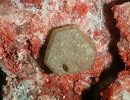
|
| Chlorargyrite |
Chemical
Formula |
AgCl |
Species |
Halides |
Crystal
System |
Isometric |
Mohs
Scale |
1-2 |
Specific
Gravity |
5.57 |
Color |
Colourless (fresh); bright chartreuse-green, light yellow, light green, grey; becoming Purple-brown on exposure to light. |
Streak |
White |
Luster |
Adamantine, Resinous, Waxy |
Refractive
Index |
n = 2.071 |
Diaphaneity |
Transparent, Translucent |
Cleavage |
None Observed |
Fracture |
Irregular/Uneven, Sub-Conchoidal |
| Geological Setting:Oxidized zone of silver deposits, especially in arid regions. |
Chlorargyrite is the mineral form of silver chloride (AgCl). Chlorargyrite occurs as a secondary mineral phase in the oxidation of silver mineral deposits. It crystallizes in the isometric - hexoctahedral crystal class. Typically massive to columnar in occurrence it also has been found as colorless to variably yellow cubic crystals. The color changes to brown or purple on exposure to light. It is quite soft with a Mohs hardness of 1 to 2 and dense with a specific gravity of 5.55. It is also known as
cerargyrite and, when weathered by desert air, as
horn silver. Bromian chlorargyrite (or embolite) is also common. Chlorargyrite is water insoluble.
It was first described in 1877 for occurrences in the Broken Hill district, New South Wales, Australia. The name is from the Greek, chloros for "pale green" and Latin for silver, argentum.


 YueGongAnBei 44051102000467
YueGongAnBei 44051102000467


 |
|